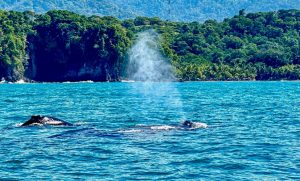Blue Morpho

We are lucky that the Blue Morpho butterflies are widespread across our area – most of us see a few flash by every day and may not think twice about it. And on numerous occasions I have been tasked with catching and removing a Morpho which flew into the house through the open patio doors. So we tend to forget that these electric insects are not so common in other parts of Costa Rica, especially the drier northern areas and while (for us) they are nothing unusual, tourist are awe-struck when they first see them. I have heard of people who visit our area specifically for the purpose of catching a glimpse of a Blue Morpho in flight – and Ben has led a few informal Blue Morpho spotting trips himself! Catching this amazing insect quietly slip out of the thick jungle and fly along the edge of a stream, road or beachside cliff before disappearing back into the forest can be an unforgettable tropical experience.
LOCAL BLUE MORPHO SPECIES
Six species of Blue Morphos call Costa Rica home but only two two of them wear the spectacularly electrifying coloration – the Morpho menelaus and Morpho peleides – their wings are almost wholly iridescent blue. The other four species have mixed coloration including black, white, brown, and darker navy blue, or are also brilliant but are considered by some experts to be subspecies of the above mentioned two, menelaus and peleides.
The Morpho family includes 29 species and, technically, each of these species, if blue, can be referred to as ‘Blue Morpho’. In this article, the name will be reserved for the Costa Rican populations of menelaus and peleides. The photo below shows a small sample of the Morpho variety.

A BIG BUTTERFLY!
The Blue Morpho is amongst the largest butterflies not only in Costa Rica, but in the world – its wingspan of nearly 5 inches (13 cm) combined with the striking coloring ensures that when a Blue Morpho is around, you will not miss it. This is especially true on sunny days when the direct sun causes their wings to glow and pierce your field of vision like bright blue laser beams. The males have larger and brighter wings as compared to the females, and are more likely to leave the forests and be seen in flight as they search for mates or chase off rivals.
THE STORY BEHIND THE IRRIDESCENT BLUE
A Blue Morpho’s wing is not actually blue! To the eye, what appears is a brilliant, metallic, shimmering blue color, probably the ‘bluest blue’ you have ever seen. But there is more to this story – at least when one talks about pigmentation, of which there is none. The wings of Blue Morphos are actually made of translucent colorless nanotube scales, tiny microscopic structures which refract and bend light in a way that creates the brilliant blue. Light is reflected between the structures, back and forth, until a brilliant shade of blue is allowed to leave the wing and hit your eye. The shade of the blue also changes with the angle between your eye and the wing, as can be seen in the photo below. This is iridescence, a type of coloring called ‘structural coloration’ which is used in the animal kingdom by peacocks to color their tail feathers, marble berries to color their brilliant fruit (the berries have the most intense color in the natural world, followed closely by the Morpho), beetles to shine in every shade of the rainbow, and by animals such as squid to quickly change color (amongst many many others).
There is a theory behind the Morpho’s brilliance – it is thought that the bright coloring is confusing to the birds that hunt the butterfly, and that it makes the butterfly appear much larger which also discourages bird and predator attacks. In fact the butterfly owes its name – Morpho – to the fact that it looks like it is changing shape in flight. In addition, the alternating flashes of bright upper wings and dark under wings makes it look like the butterfly appears and then disappears, teleporting to another place as it then appears again – more confusion! Unfortunately it is this same brilliance which makes the Morpho attractive to another predator – humans who collect the animals for museums, private collections, as curiosities or for use in art and jewelry items.

In the photo below, looking at the scale, it would take 2,000 of these tall thin nanostructures, lined against each other, to stretch over a length of just 1 millimeter – so you now have an appreciation of how elaborate the Blue Morpho’s wing scales actually are! So small, in fact, that they cannot be imaged using conventional optical microscopes, only by an electron microscopes.

WHAT ABOUT THE ‘CAT EYES’ ON THE BACK OF THEIR WINGS?
You may have noticed that the back side of the Blue Morpho wing is nothing like the front side. Gone is the flashing blue, replaced by a darker brown shading with a peculiar marking seen on many other animals including insects, fish, birds, reptiles and mammals – a pair of false eyes, or ‘eyespots’. The darker coloring serves as camouflage for when the butterfly is resting or feeding and, as you have guessed, the Blue Morphos use the eyespot markings to discourage predators from harming the butterfly – by both scaring the attacking animals by making the butterfly appear to be a much larger creature, and by deflecting the attack towards the less vulnerable body areas. Interestingly, while many animals use eyespots for the same purpose, some use them for other purposes – such as attracting a mate (peacock), encouraging their pups to follow them (several species of wildcats), or for camouflage (seen in some butterflies) – but that is a fascinating topic for another article.


LIFE CYCLE
The female Morpho lays around 12 eggs on the underside of a leaf – most likely a pea species, as this is the favorite food of the caterpillars. The eggs adapt to the environment and may change color based on the changing colors of the surrounding plants – they are usually green with a brown spot but can become transparent or brown. The caterpillars are reddish brown with bright green patches and are covered with bristles which will irritate skin if touched. The majority of the caterpillars hatch during the dry season and, if conditions get too dry and hot, they can enter a period of suspended development while they wait for more appropriate weather during which to complete their transformation into butterflies. The animals spend about 2 weeks as eggs, 10 weeks as caterpillars and 1-4 weeks as an adult butterfly, with most transforming into their final form around the start of the rainy season – though the transformations take place year round and there isn’t a time when they are not seen, at least in our Costa Ballena area. The only exception may be during periods of intense rain – the Morphos do not fly around in these conditions as the heavy tropical drops can easily damage their wings.

FEEDING
Blue Morphos, in their caterpillar form, predominantly feed on pea plants – and it is the chemicals inside these plants that allow the caterpillars to wear irritating bristles and adult butterflies to be poisonous to many species of potential predators. Adults feed on rotting fruit by sucking the nutritious juices. A common Morpho butterfly feeder consists of placing rotting fruit on a wooden plank – this attracts the Morphos and can make for a great conversation piece, especially if cold climate friends or relatives are over for a visit. The butterflies are also known to sip on fungi and even the juices of decomposing animals. They prefer to spend most of their time in the cover of the jungle and will descend to the forest floor in search of food.

GOOD LUCK WITH YOUR CAMERA!
As I and many have found, Blue Morphos are almost impossible to photograph in flight. Their flight is erratic and unpredictable so setting up a shot in advance is a pipe dream. The brilliantly bright iridescence of their wings also tends to play havoc with the camera sensors, so the best you can hope for is a blurry smudge of electric blue. Catching one while it is taking a break is equally frustrating – the butterflies tend to fold their wings while resting so you may get a nice photo of the eyespots, but that is about it – and that is if you are lucky enough to find one when it is taking a break, which you will not be! It is best to head to a local butterfly conservatory where you will have a much better chance of getting that shot.
THREATS
For a while, Costa Rica’s Morphos were under a lot of pressure due to the destruction of rainforests and hunting by butterfly collectors. The jungles are coming back as the country is moving through a period of intense re-forestation and hunting is not such a big issue anymore – so thankfully the Costa Rican Morphos are doing very well. They may face pressure in areas of heavy development but overall they are not classified as threatened. And as I mentioned, there are very common in our Costa Ballena area.
Imagine living in an unspoiled paradise where amazing picture-book animals like the Blue Morpho are seen daily – but at the same time being just steps away from modern amenities: shops and supermarkets, great restaurants, entertainment, and countless tourist attractions like ziplining, scuba diving or deep sea fishing. Let us make your dreams a reality – visit the RE/MAX We Sell Paradise property section to view the hot properties in our local area: https://www.we-sell-paradise.com
All photos courtesy of Wikicommons.



